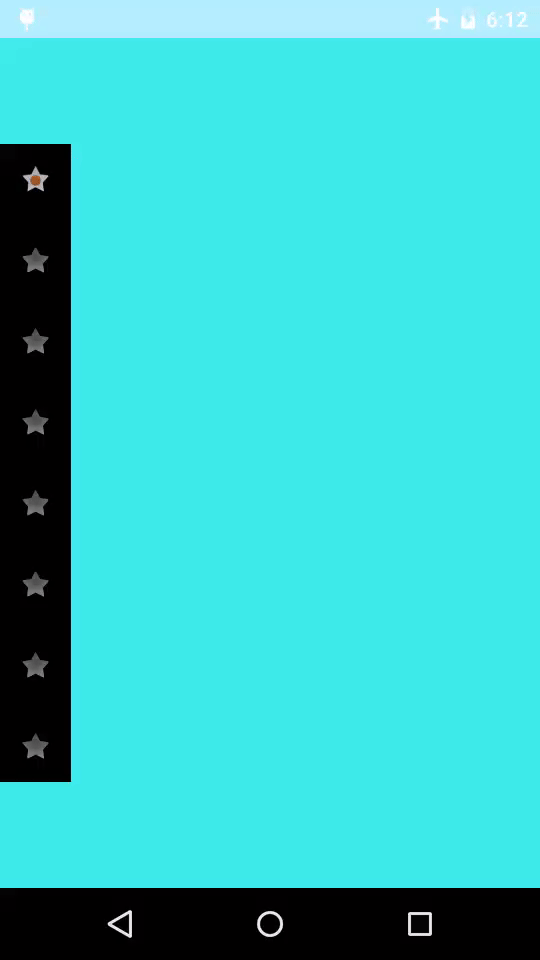CutoutViewIndicator
These indicators animate every little touch on your ViewPager.
Want to use a SpinningViewPager instead? Just enable an offset and you're good to go. Need even finer control? Under the hood, CutoutViewIndicator extends LinearLayout; cell styling is done through LayoutParams. You can set individual values dynamically on these params and Android's View save/restore state logic will keep them in order.
You can define each cell directly in your xml file, or add them manually. Note that the Generators shipped with this library only support ImageViews and TextViews. We expect the vast majority of integrations will be satisfied with the default Generator choices.
There is functional support for RecyclerViews in the included mobile app code - check out RecyclerStateProxy for details.
Pictures:
The sample mobile app in use:


There's demo source code for mobile under the mobile directory; we're
looking to expand compatibility to Android Wear and Android TV too.
Adding to a gradle project:
In your app-level build.gradle: ensure your repository list includes
jitpack.io, then add the artifact as a dependency.
repositories {
maven {
url "https://jitpack.io"
}
}
dependencies {
compile 'com.github.fuzz-productions:CutoutViewIndicator:v0.9.0'
}
Sample code:
Add a view like this to your xml layout.
<com.fuzz.indicator.CutoutViewIndicator
android:id="@+id/indicator"
android:layout_width="wrap_content"
android:layout_height="wrap_content"
android:layout_below="@id/cutoutViewIndicator"
android:orientation="horizontal"
app:rcv_drawable="@drawable/indicator"
app:rcv_drawable_unselected="@drawable/indicator_background"
app:rcv_internal_margin="@dimen/indicator_internal_spacing"
app:rcv_tools_indicator_count="4"
/>
Note that rcv_drawable and rcv_drawable_unselected default to 0. You won't see the indicator unless rcv_drawable is set to something,
so be sure not to forget about it.
You can leave rcv_drawable_unselected equal to 0 if you want a
transparent background.
In your Java (or other JVM-compatible language) file, get a reference to the view and set it up with a ViewPager.
ViewPager pager;
pager.setAdapter(adapter);
// Activity
CutoutViewIndicator cvi = (CutoutViewIndicator) findViewById(R.id.indicator);
cvi.setViewPager(pager);
...
// Fragment
CutoutViewIndicator cvi = (CutoutViewIndicator) view.findViewById(R.id.indicator);
cvi.setViewPager(pager);
...
// DataBinding
CutoutViewIndicator cvi = binding.indicator;
cvi.setViewPager(pager);
Then you're good to go. When you're done with the view, it's probably a good idea to de-initialise the CutoutViewIndicator.
cvi.setViewPager(null);
If you want to use something other than simple ImageViews, you can set your own Generator on the object.
cvi.setGenerator(new GifGenerator());
ImageCellGenerator is designed for extensibility - consider
subclassing your custom Generator from that if its views extend
ImageView.
The base library also ships with an experimental CutoutCellGenerator
called TextCellGenerator. Check out the javadoc for details on how
to work with it.
License
Copyright 2016-2019 Philip Cohn-Cort and Fuzz Productions
Licensed under the Apache License, Version 2.0 (the "License");
you may not use this file except in compliance with the License.
You may obtain a copy of the License at
http://www.apache.org/licenses/LICENSE-2.0
Unless required by applicable law or agreed to in writing, software
distributed under the License is distributed on an "AS IS" BASIS,
WITHOUT WARRANTIES OR CONDITIONS OF ANY KIND, either express or implied.
See the License for the specific language governing permissions and
limitations under the License.
Caveats
Right now it only supports Android SDK 14 and up (that makes it compatible with Ice Cream Sandwich, Jelly Bean, Lollipop, Marshmallow, and Nougat), but there's little stopping it from being backported all the way to APIv11.
Grab a copy of the demo application (live apk coming soon) to try it in action.
Credit:
This project was inspired by the work of others in the Android community, especially ViewPagerIndicator and AvatarImageView.
